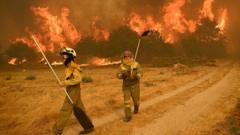The upcoming national elections in Australia highlight significant differences in candidates' climate and energy policies, influencing the nation's reliance on fossil fuels and its global warming footprint.
Australia's Election and Its Climate Impact: A Look at Energy Policies

Australia's Election and Its Climate Impact: A Look at Energy Policies
As Australia heads into elections, candidates' diverse climate strategies could redefine the nation's energy future.
In the heat of the upcoming national elections, Australians find themselves in a unique position regarding climate change action, with the pressure on their current affairs heightened by their status as major greenhouse gas emitters. Only the United States and Canada rival Australia's per capita emissions levels, while the country remains a leading exporter of fossil fuels, particularly coal and natural gas, to fast-growing economies in Asia.
Despite these stark realities, current polling suggests that climate change may not feature as a primary concern for many voters on ballot day. However, the contest between the Labor Party and the Liberal-National Coalition reveals a pronounced division in their proposed energy and climate strategies.
Central to the election discourse is Australia's dependency on an outdated collection of coal-powered plants for electricity generation. Andrew Macintosh, an expert in environmental law at the Australian National University, stated, “Regardless of climate considerations, that fleet needs retirement.” The Labor Party advocates for an expansion of renewable sources, whereas the Conservative Coalition favors a nuclear-centered energy model.
Though both strategies are projected to reduce emissions, Macintosh points out the practical challenges of the nuclear proposal. Nuclear facilities require extensive construction periods—often exceeding ten years—while renewable energy projects can be operational in mere months. “Keeping coal plants functional during the nuclear transition would lead to extended years of pollution and high costs,” he emphasized.
As the elections approach, the outcomes may carry significant implications for Australia's energy policies and overall contribution to climate change.
Despite these stark realities, current polling suggests that climate change may not feature as a primary concern for many voters on ballot day. However, the contest between the Labor Party and the Liberal-National Coalition reveals a pronounced division in their proposed energy and climate strategies.
Central to the election discourse is Australia's dependency on an outdated collection of coal-powered plants for electricity generation. Andrew Macintosh, an expert in environmental law at the Australian National University, stated, “Regardless of climate considerations, that fleet needs retirement.” The Labor Party advocates for an expansion of renewable sources, whereas the Conservative Coalition favors a nuclear-centered energy model.
Though both strategies are projected to reduce emissions, Macintosh points out the practical challenges of the nuclear proposal. Nuclear facilities require extensive construction periods—often exceeding ten years—while renewable energy projects can be operational in mere months. “Keeping coal plants functional during the nuclear transition would lead to extended years of pollution and high costs,” he emphasized.
As the elections approach, the outcomes may carry significant implications for Australia's energy policies and overall contribution to climate change.



















